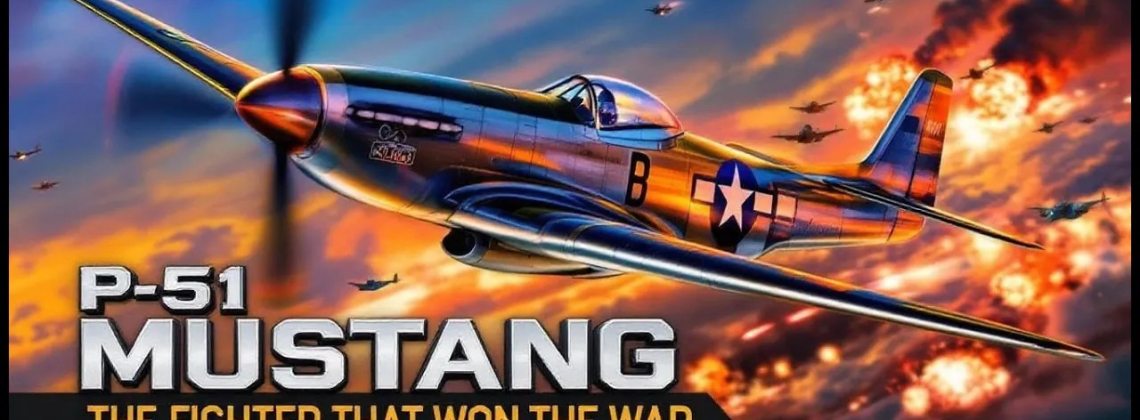
In the darkest days of World War II, the skies over Europe and the Pacific became the stage for intense aerial battles. Amidst this chaos emerged a legendary fighter aircraft that would not only turn the tide of war but also become an enduring symbol of courage and innovation: the P-51 Mustang. This wasn’t just another fighter plane—it was *the* fighter. Its legacy as a game-changer in aerial warfare resonates far beyond the war years.
A Fighter Born of Urgency
The P-51 Mustang’s journey began in 1940 when Britain’s desperate need for advanced fighters sparked its development. Designed by North American Aviation in record time, the Mustang was initially powered by an Allison engine. However, its true potential was unlocked when the Rolls-Royce Merlin engine was introduced. This transformation turned the aircraft into a high-altitude powerhouse, capable of chasing down German Luftwaffe planes, engaging in vertical climbs, and diving with astounding speed—all while covering vast distances without refueling.
With a top speed of 437 miles per hour and a service ceiling of over 41,900 feet, the Mustang wasn’t just fast—it was revolutionary. Yet, its most significant advantage wasn’t its speed, but its range. Equipped with external fuel tanks, the Mustang could escort Allied bombers deep into German territory and back, a feat unmatched by any other Allied fighter of its time.
Turning the Tide of War
Before the Mustang, bombing missions over Germany were perilous, with high losses of B-17 and B-24 bombers. The arrival of the Mustang changed the game. Suddenly, Allied bombers weren’t easy targets for the Luftwaffe. In late 1943, the U.S. Eighth Air Force was losing 9% of its bombers on missions. By mid-1944, with Mustangs flying top cover, losses dropped to just 3%. The Luftwaffe’s dominance in daylight skies was shattered.
The psychological impact was equally profound. For Allied bomber crews, the sight of Mustang escorts circling above was a source of hope. Missions that once seemed suicidal now had a fighting chance. Meanwhile, German pilots who had once ruled the skies were now outpaced, outflanked, and outgunned by these sleek, agile fighters.
Operation Argument: A Defining Moment
One of the Mustang’s most significant contributions came during Operation Argument, also known as the “Big Week,” in February 1944. This massive Allied bombing campaign targeted German aircraft production facilities. Escorting hundreds of bombers deep into Nazi territory, the Mustang pilots lured the Luftwaffe into battle, decimating their ranks. By the end of the campaign, Germany’s air defenses were crippled. The loss of experienced pilots and planes dealt a blow from which the Luftwaffe would never recover.
The Art of Dogfighting
Dogfights in World War II were harrowing and up-close encounters, demanding skill, speed, and split-second decisions. Success hinged on three key factors: altitude (the “high ground”), energy (a combination of speed and altitude), and positioning (getting behind the enemy). The P-51 Mustang excelled in all three areas.
Its laminar flow wing design, coupled with its exceptional maneuverability and six .50 caliber Browning M2 machine guns, made it a formidable opponent. German fighters like the Messerschmitt Bf 109 and Focke-Wulf Fw 190 struggled to match its capabilities. The Mustang wasn’t just a plane—it was a predator in the skies.
Legacy of the Mustang
By 1944, the Mustang played a pivotal role in securing Allied air superiority over Europe. This dominance wasn’t just a tactical win—it was a strategic necessity. Without control of the skies, major operations like the D-Day landings in June 1944 could have ended in disaster. Instead, with Mustangs patrolling above, the Allies had the freedom to move troops, supplies, and strike critical targets.
Even in the Pacific theater, the Mustang proved its worth, escorting B-29 bombers on long-range missions over Japan. Mustang pilots faced relentless danger, from enemy fighters to anti-aircraft fire. Yet, their courage and skill ensured the bombers reached their targets and returned safely.
More Than a Machine
The P-51 Mustang wasn’t just a tool of war—it was a symbol of Allied resilience and ingenuity. Its roaring Merlin engine and polished aluminum body evoke awe even today, serving as a reminder of the bravery and sacrifices made by those who flew and maintained them. For many, it represents the spirit of a generation that stood firm in the face of adversity and triumphed.
Conclusion
The P-51 Mustang didn’t just dominate the skies during World War II—it defined an era of aerial warfare. From its revolutionary design to its unmatched performance in combat, the Mustang turned the tide of the war, saving countless lives and paving the way for ultimate victory. Its legacy is a testament to the innovation, teamwork, and bravery that shaped one of history’s most pivotal moments.
What stands out most to you about the P-51 Mustang’s impact on WWII? Share your thoughts in the comments below and join the conversation about this legendary aircraft. 🌟
